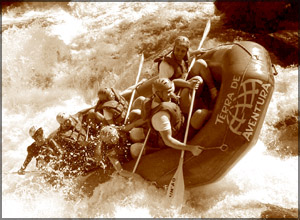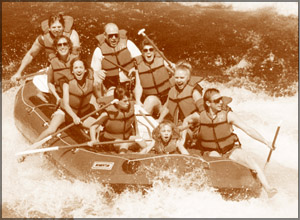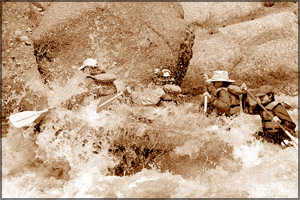Rafting
Rafting or whitewater rafting is a
recreational activity utilizing a raft to navigate a river or other
bodies of water. This is usually done on whitewater or different degrees
of rough water, in order to thrill and excite the raft passengers. The
development of this activity as a leisure sport has become
popular since the mid 1970s.
Whitewater rafts
 Rafts
were originally the simplest form of man's transportation in water and
were then made of several logs, planks or reeds which were fastened
together. Nowadays, inflatable boat were used as rafts which were later
adopted by the military for beach assaults. Rafts
were originally the simplest form of man's transportation in water and
were then made of several logs, planks or reeds which were fastened
together. Nowadays, inflatable boat were used as rafts which were later
adopted by the military for beach assaults.
It consists of very durable, multi-layered rubberized or vinyl
fabrics with several independent air chambers. Its length varies between
3.5 m (11 ft) and 6 m (20 ft), the width between 1.8 m (6 ft) and 2.5 m
(8 ft). The exception to this size rule is usually the packraft, which
is designed as a portable single-person raft and may be as small as 1.5m
long and weigh as little as 4 lbs.
Rafts come in a few different forms. In Europe the most common is the
symmetrical raft steered with a paddle at the stern. Other types are the
asymmetrical, rudder-controlled raft and the symmetrical raft with
central helm (oars). Rafts are usually propelled with ordinary paddles
and typically hold 4 to 12 persons.
In Russia rafts are often hand made and are often a catamaran style
with two inflatable tubes attached to a frame. Pairs of paddlers
navigate these rafts. Catamaran style rafts have become popular in the
western United States as well, but are typically rowed instead of
paddled.
Safety
 Whitewater
rafting can be a dangerous sport, especially if basic safety precautions
are not observed. Both commercial and private trips have seen their
share of injuries and fatalities, though private travel has typically
been associated with greater risk. Depending on the area, legislated
safety measures may exist for rafting operators. Whitewater
rafting can be a dangerous sport, especially if basic safety precautions
are not observed. Both commercial and private trips have seen their
share of injuries and fatalities, though private travel has typically
been associated with greater risk. Depending on the area, legislated
safety measures may exist for rafting operators.
These range from certification of outfitters, rafts, and raft
leaders, to more stringent regulations about equipment and procedures.
It is generally advisable to discuss safety measures with a rafting
operator before signing on for a trip. The equipment used and the
qualifications of the company and raft guides are essential information
to be considered.
Like most outdoor sports, rafting in general has become safer over
the years. Expertise in the sport has increased, and equipment has
become more specialized and increased in quality. As a result the
difficulty rating of most river runs has changed.
A classic example would be the Colorado River in the Grand Canyon,
which has swallowed whole expeditions in the past, leaving only
fragments of boats but is now run safely by commercial outfitters
hundreds of times each year, with relatively untrained passengers. [2]
Risks in whitewater rafting stem from both environmental dangers and
from improper behavior. Certain features on rivers are inherently unsafe
and have remained consistently so despite the passage of time.
These would include "keeper hydraulics", "strainers" (e.g. fallen
trees), dams (especially low-head dams, which tend to produce river-wide
keeper hydraulics), undercut rocks, and of course dangerously high
waterfalls. Rafting with experienced guides is the safest way to avoid
such features.
 Even
in safe areas, however, moving water can always present risks -- such as
when a swimmer attempts to stand up on a rocky riverbed in strong
current, risking foot entrapment. Irresponsible behavior related to
rafting while intoxicated has also contributed to many accidents. Even
in safe areas, however, moving water can always present risks -- such as
when a swimmer attempts to stand up on a rocky riverbed in strong
current, risking foot entrapment. Irresponsible behavior related to
rafting while intoxicated has also contributed to many accidents.
To combat the illusion that rafting is akin to an amusement park
ride, and to underscore the personal responsibility each rafter faces on
a trip, rafting outfitters generally require customers to sign waiver
forms indicating understanding and acceptance of potential serious
risks. Rafting trips often begin with safety presentations to educate
customers about problems that may arise.
Due to this the overall risk level on a rafting trip with experienced
guides using proper precautions is low.[citation needed] Thousands of
people safely enjoy raft trips every year.
Issues with rafting
Like all wilderness sports, rafting has to balance the conflict
between nature protection and nature use. Because of frequent problems
in the past, some rivers now have regulations restricting or specifying
the annual and daily operating times.
Conflicts have also arisen with environmentalists when rafting
operators, often in co-operation with municipalities and tourism
associations, alter the riverbed by dredging and/or blasting in order to
eliminate safety risks or create more interesting whitewater features in
the river. Incongruously these measures usually are only temporary,
since a riverbed is subject to permanent changes.
On the other hand, rafting contributes to the economy of many alpine
regions which in turn may contribute to the protection of rivers from
hydroelectric power generation and other development. Additionally,
white water rafting trips can promote environmentalism.
By experiencing first hand the beauty of a given river, individuals
who would otherwise be indifferent to the environmental concerns of an
area may gain a strong desire to protect and preserve that area because
of a positive outdoors experience. |
